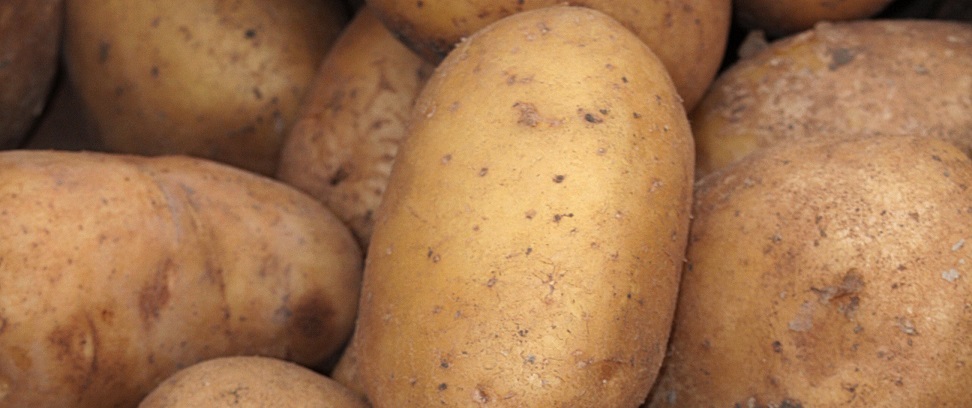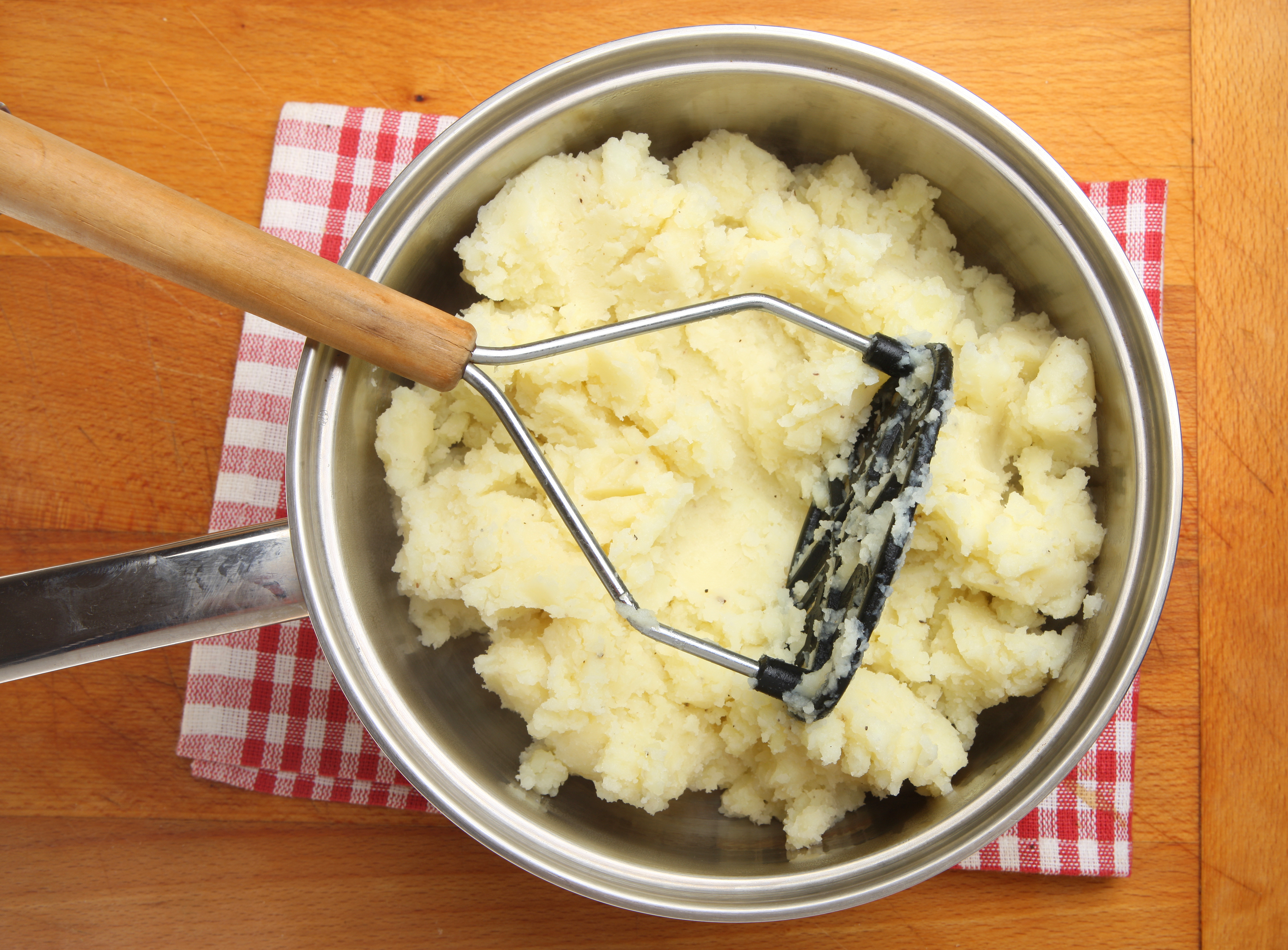Mashed potatoes are just fine when simply and classically prepared for the purists among us. However, you can take them off the chart by combining them with some tempting add-ins and just a tad more effort.

Which Potato?
Idaho russet potatoes were, for a long time, the top pick for perfect mashed potatoes. In recent years, however, Yukon Gold potatoes have been winning over the hearts and palates of mashed potato aficionados. Each potato, however, represents a different style, so it’s really hard to say which is better because it all depends on your taste preferences.
Idaho russets are a high-starch/low-water potato—perfect for baking and break down readily when incorporated with other foods. Mashed russets are drier and require more liquid and fat to become creamy.
Yukon Golds have moderate starch and water content. They tend to be lighter and fluffier when mashed.
Skin on or skin off is also a matter of taste preference. The skins add a rustic drier, toothier element to the mash, whereas skinless mashed potatoes are sublime when whipped to perfection.
How to Treat a Potato
How you go about mashing potatoes is also a matter of preference—lumpy or smooth.
Hand mashing with a wooden spoon or a proper potato masher is very rustic and translates the idea of homemade into the actual taste and texture. Small lumps dispersed among a creamy puree has a wonderful mouthfeel that gives you something to chew.
Using a hand mixer speeds up the mashing process and results in a smoother texture. However, be careful not to overdo it. Too much beating with the mixer may overwork the starch in the potatoes and cause them to go from fluffy to waxy.
Whether you choose to boil the potatoes whole or pre-cut into chunks or dice is also a matter of preference. However, it is always best to mash the potatoes first while they are hot, and then add butter, cream, etc., after the mash is almost to the desired consistency. Adding cold ingredients first lowers the temperature of the potatoes and makes them more difficult to mash and blend in the cold ingredients evenly.
Potatoes Plus
Try sauteing just about any single kind or a combination of mushrooms in butter or olive oil. Add to the mushrooms some minced garlic, fresh thyme, and parsley with a splash of dry sherry and a spot of turkey stock. Then, just fold them in with the mashing is done. Just fold them in when the mashing is done.
Shredded or grated cheese—Parmigiano, Asiago, or Romano—adds another layer of luxurious taste.
Experiment with whatever is on hand: leeks, caramelized sweet onions, shallots, or roasted garlic, as well as such fresh herbs as sage, rosemary, marjoram, chives, scallions, or smoked paprika.
A flavored compound butter, such as black truffle butter, Tuscan herb, or porcini-sage butter, is another easy substitute in the basic mash for added depth of flavor with virtually no extra effort.
Guiltless Indulgence
If you are being on good behavior, the anything-goes type of mashed potato might not be for you. There are, however, options that are not as indulgent, but they are a far more reasonable alternative than no mash at all.
You can control calories by selecting a dairy product other than cream. Skim milk, 1% or 2% milk, and half-and-half all can be used to scale down the fat content. For an even lower-fat variation, try using chicken or turkey stock. Low-fat sour cream or low-fat cream cheese are good choices for lower-fat options that retain a very pleasant mouthfeel.
As for a complete mashed potato substitute, cauliflower boiled or steamed until soft and then mashed with the usual flavorings is a low-starch, low-carb alternative that just may surprise you with what a good and healthful substitute it is.
Variations on a Theme
With stuffing, mashed potatoes, and all manner of desserts, Thanksgiving dinner can be a journey into carbohydrate oblivion. But why stop there? Taking a step beyond traditional white potatoes for mashing—sweet potatoes offer another variation that doesn’t require an either-or choice when you can serve them side-by-side.
Sweet potatoes come in all shapes, sizes, and textures. And while some varieties are suited for mashing, others are better for roasting or glazing. To help you sort out which is which, here’s a great photo guide to sweet potatoes from Saveur Magazine?
Whereas white mashed potatoes have an affinity for savory flavors, mashed sweet potatoes tend to favor warm and sweet flavors. So, after adding cream and butter, try incorporating cinnamon, nutmeg, brown sugar, maple syrup, orange juice, or apple cider.
You could also sauté thinly sliced apples or pears in a bit of butter and brown sugar and then fold them into the sweet potato mash. Or poach the slices in cider until soft before adding to the mash.
Get Smashed
We’re still discussing potatoes—not how much you imbibe on turkey day.
Smashed potatoes are an entirely non-traditional way of preparing potatoes. But what they lack in tradition, they more than make up in absolute deliciousness—and fun!
To make smashed potatoes you need baby potatoes boiled until fork-tender. Take the potatoes out of the water and let them cool just enough to handle them comfortably. With the heel of your hand or the side of a heavy cleaver, press down on each potato until the skin breaks and the potato collapses on itself into a patty shape.
Take the flattened potatoes and spread them on a cookie sheet in a single layer. Top with a drizzle of extra-virgin olive oil and a sprinkling of salt, pepper, and any other seasonings or grated cheese of your choice. Roast in a 375oF oven for about 20 minutes until the outsides turn golden.
Smashed potatoes can also be made as regular mashed potatoes, just leave them in a very chunky texture, rather than smooth.

How do you take your potatoes on Thanksgiving Day? What style do you prefer—smooth as silk, chunky, smashed? What’s your favorite mix-in?



Leave Your Response